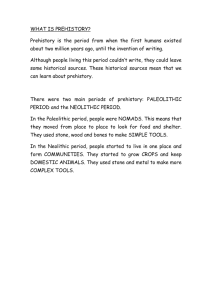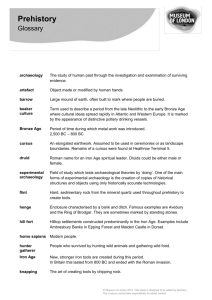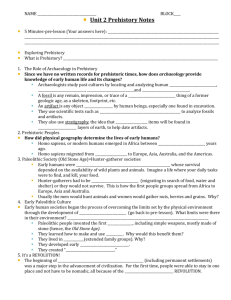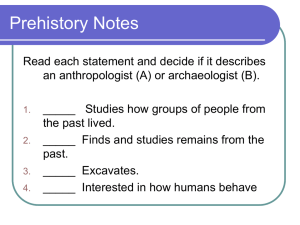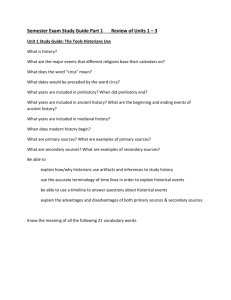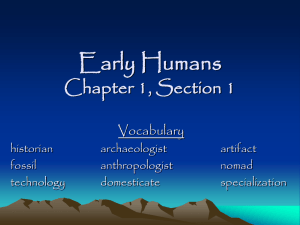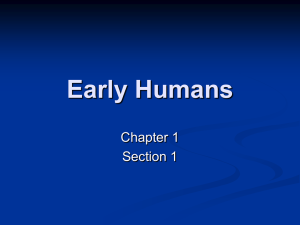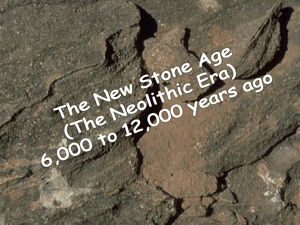AP Art History- Summer Assignment
advertisement
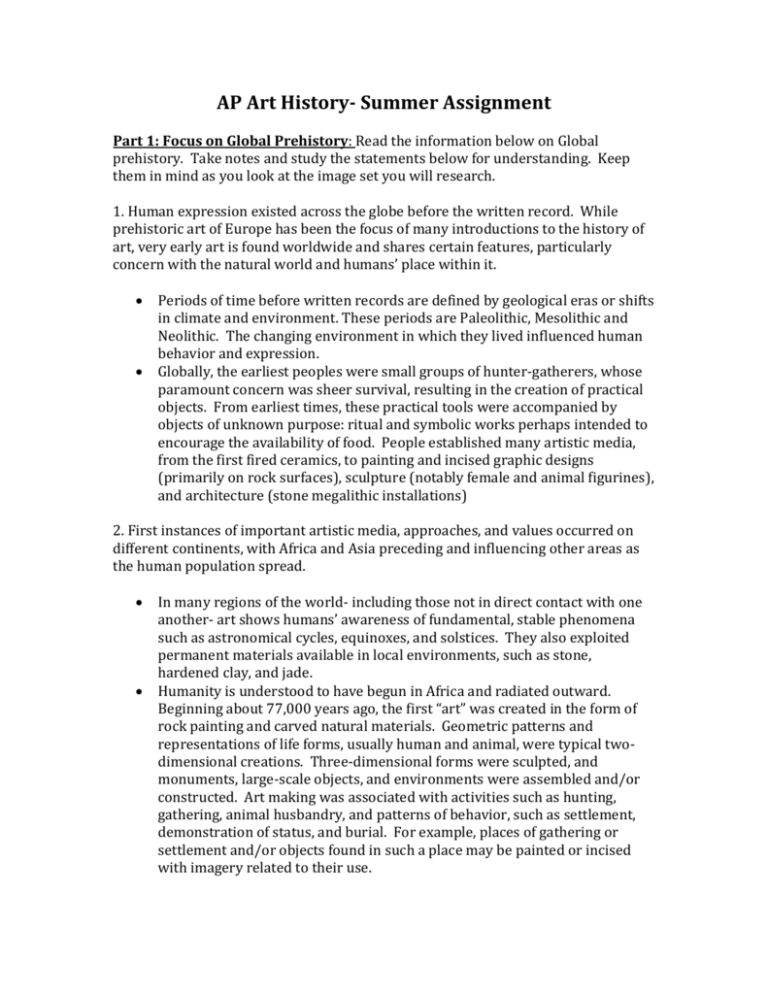
AP Art History- Summer Assignment Part 1: Focus on Global Prehistory: Read the information below on Global prehistory. Take notes and study the statements below for understanding. Keep them in mind as you look at the image set you will research. 1. Human expression existed across the globe before the written record. While prehistoric art of Europe has been the focus of many introductions to the history of art, very early art is found worldwide and shares certain features, particularly concern with the natural world and humans’ place within it. Periods of time before written records are defined by geological eras or shifts in climate and environment. These periods are Paleolithic, Mesolithic and Neolithic. The changing environment in which they lived influenced human behavior and expression. Globally, the earliest peoples were small groups of hunter-gatherers, whose paramount concern was sheer survival, resulting in the creation of practical objects. From earliest times, these practical tools were accompanied by objects of unknown purpose: ritual and symbolic works perhaps intended to encourage the availability of food. People established many artistic media, from the first fired ceramics, to painting and incised graphic designs (primarily on rock surfaces), sculpture (notably female and animal figurines), and architecture (stone megalithic installations) 2. First instances of important artistic media, approaches, and values occurred on different continents, with Africa and Asia preceding and influencing other areas as the human population spread. In many regions of the world- including those not in direct contact with one another- art shows humans’ awareness of fundamental, stable phenomena such as astronomical cycles, equinoxes, and solstices. They also exploited permanent materials available in local environments, such as stone, hardened clay, and jade. Humanity is understood to have begun in Africa and radiated outward. Beginning about 77,000 years ago, the first “art” was created in the form of rock painting and carved natural materials. Geometric patterns and representations of life forms, usually human and animal, were typical twodimensional creations. Three-dimensional forms were sculpted, and monuments, large-scale objects, and environments were assembled and/or constructed. Art making was associated with activities such as hunting, gathering, animal husbandry, and patterns of behavior, such as settlement, demonstration of status, and burial. For example, places of gathering or settlement and/or objects found in such a place may be painted or incised with imagery related to their use. Humans established Paleolithic communities in West Central, South, Southeast, and East Asia (Saudi Arabia, Yemen, Iran, India, China, Japan) between 70,000 and 40,000 B.C.E. In China, ritual objects made of jade started a 5,000 year tradition of working in this precious medium. Asia’s greatest contribution to early world art is in ceramic technology, with some of the earliest pieces (dating to 10,500 B.C.E.) produced by the Jomon culture in Japan. Even earlier pottery continues to be found, particularly in China. Ceramics were also produced in Iran beginning in the eighth millennium B.C.E., and refined vessel forms arose from the adoption of the potter’s wheel in the fourth millennium B.C.E. In the Pacific region, migrations from Asia approximately 45,000 years ago were possible because of lowered sea levels and the existence of land bridges. The earliest created objects have been dated to about 8,000 years ago. The Lapita peoples, who moved eastward from Melanesia to Polynesia beginning about 4,000 years ago, created pottery with incised geometric designs that appear across the region in multiple media today. Paleolithic and Neolithic Europe’s Artistic statements were made in small human figural sculptures (central Europe), cave painting (France and Spain), and outdoor, monumental stone assemblages (British Isles). These provide glimpses into the beginning of ritual life (15,000 B.C.E.) as people tried to influence and integrate with the natural cycle of the cosmos and promote both human and animal fertility. These works establish the dynamic interplay of naturalism and abstraction found throughout history art’s history. On the American continent, from the Arctic to Tierra del Fuego, indigenous peoples who had recently migrated from Asia (before 10,000 B.C.E.) first made sculptures from animal bone and later from clay, with animals and sacred humans as dominant subject matter. Similar to European expressions, ancient American art adapts animal images to the natural contours of the chosen materials and features fecund females. The fact that female figurines may also display unusual or supernatural characteristics suggests the importance of shamanic religion brought from Asia very early in human history. 3. Over time, art historian’s knowledge of global prehistoric art has developed through interdisciplinary collaboration with social and physical scientists. Use of carbon dating, and comparison of people, objects and religions today by archaeologists have helped to establish a general theory of the function and meaning of prehistoric art. Since it was first practiced circa 1900, modern stratigraphic archaeology (recording precisely each level and location of all objects) has served for the basis for art historical studies. Archaeology supports the understanding of how people, culture, and therefore art traveled across the globe before written records were kept. Important sites like the caves at Lascaux, or media like ceramics were first discovered by archaeologists and then became available for interpretation by art historians- the two disciplines are highly complementary. The function of artistic expression prior to written records is inferred from evidence of technology and survival strategies and based on the relation of tools and their function (whether task related or expressive), available food source, the rise of sophisticated culture, and humans’ capacity to shape and manage the environment. These theories are continually proposed, tested, refined, and potentially rejected by conflicting evidence or new information, as in other periods of art history and in other disciplines. Part II Image Set: Research on the Internet or at the library the following artifacts from Global Prehistory. Use these artifacts as concrete examples of the information you read, took notes on, and digested. Examine each one in context with the notes above. We will discuss and be tested on these artifacts during the first week of class. If you have any problems finding these artifacts please don’t hesitate to e-mail me at Richard.debiase@whschools.org 1. Apollo 11 stones. Namibia. c.25,000-25,300 B.C.E. Charcoal on stone. 2. Great Hall of the Bulls. Lascaux, France. Paleolithic Europe. 15,000- 13,000 B.C.E. Rock painting. 3. Camelid sacrum in the shape of a canine. Tequixquiac, central Mexico. 14,000- 7,000 B.C.E. Bone. 4. Running horned woman. Tassili n’Ajer, Algeria. 6,000-4,000 B.C.E. Pigment on rock. 5. Bushel with ibex motifs. Susa, Iran. 4,200-3,500 B.C.E. Painted terra cotta. 6. Anthropomorphic stele. Arabian Peninsula. Fourth Millenium B.C.E. Sandstone. 7. Jade cong. Liangzhu, China. 3,300-2,200 B.C.E. Carved jade. 8. Stonehenge. Wiltshire, UK. Neolithic Europe. C. 2,500-1,600 B.C.E. Sandstone. 9. The Ambum Stone. Ambum Valley, Enga Province, Papua New Guinea. C. 1,500 B.C.E. Greywacke. 10. Tlatilco female figurine. Central Mexico, site of Tlatico. 1,200-900 B.C.E. Ceramic. 11. Terra cotta fragment. Lapita. Solomon Islands, Reef Islands. 1,000 B.C.E. Terra cotta (incised). Part III: Museum Visit There are several amazing museums very close to West Haven. In order to complete the summer assignment you will have to visit one of them. Suggested museums are The Yale Art Gallery, The Yale Center for British Art, and The New Britain Museum of American Art. If you feel ambitious take a train ride to New York City and visit The Metropolitan Museum of Art or The Museum of Modern Art! Maybe you could organize a group and go with some friends? The purpose of this visit is to get you to look at lots and lots of art. Seeing Art LIVE is always the best way to experience it. This project will be due the first week of class. Museum Assignment: Choose one work of art that was made after 1940. Compare the work to an artifact from the list from Global Prehistory. Write down your observations and original thoughts in a well thought out essay with an introduction, body and conclusion. Take pictures of the work (please review the museum guidelines for photography. Most allow it if there is no flash). This essay will be due during the first week of class when you will present your observations to the class. A FEW MORE IMPORTANT THINGS: I don’t accept late work at the AP level. If you’re going to be absent, email me your work. It’s that easy. If you have any questions or concerns email me at richard.debiase@whschools.org Have a great summer!
